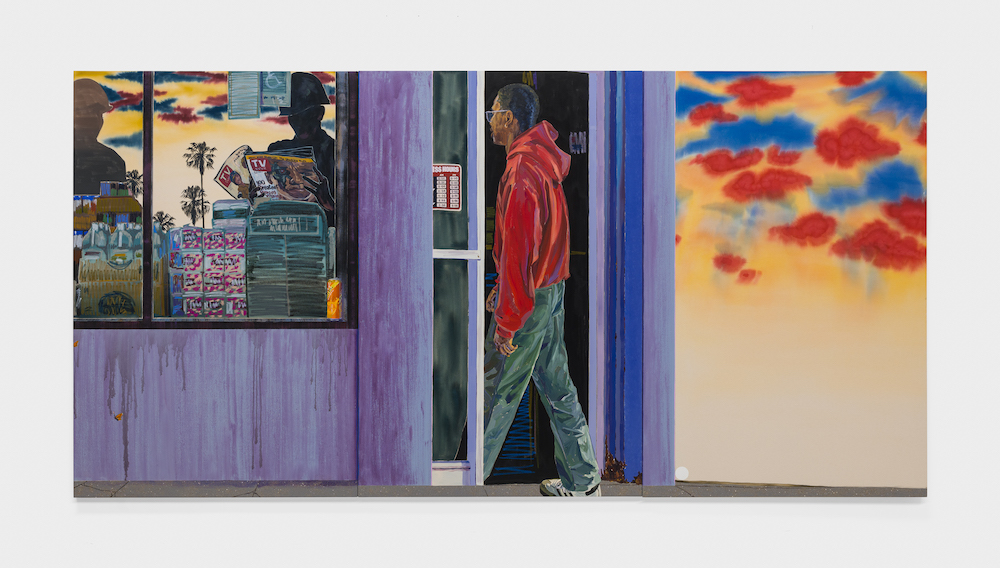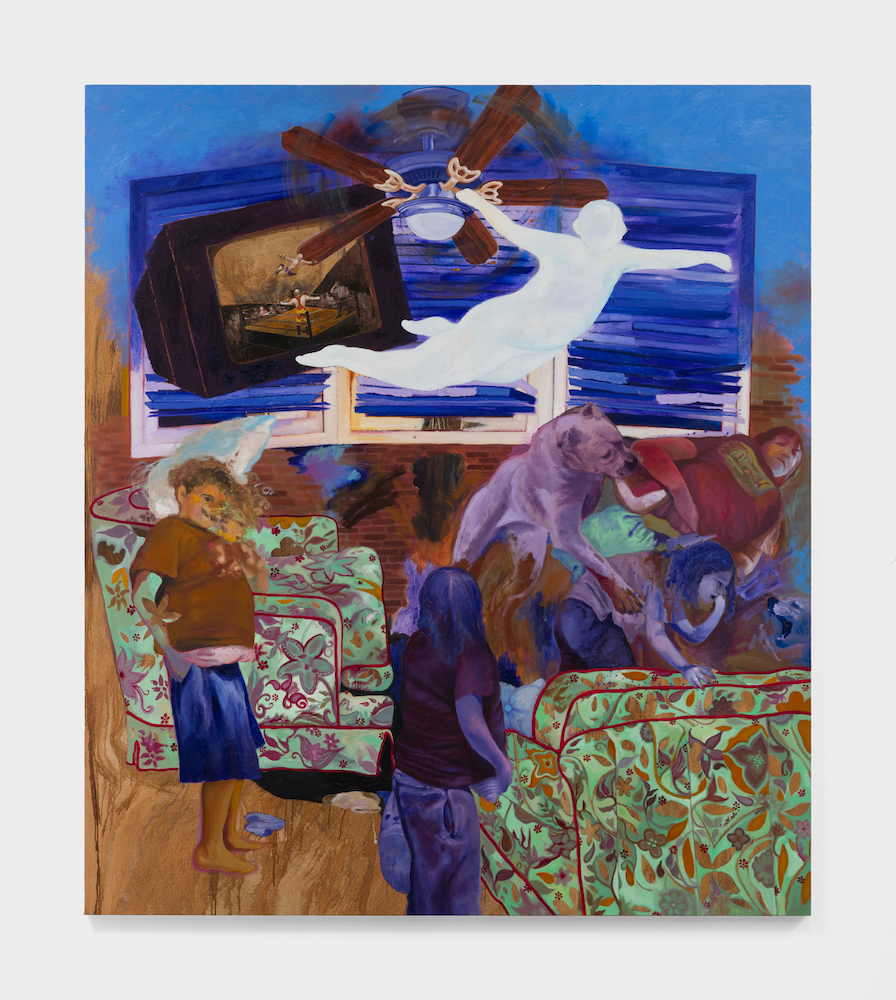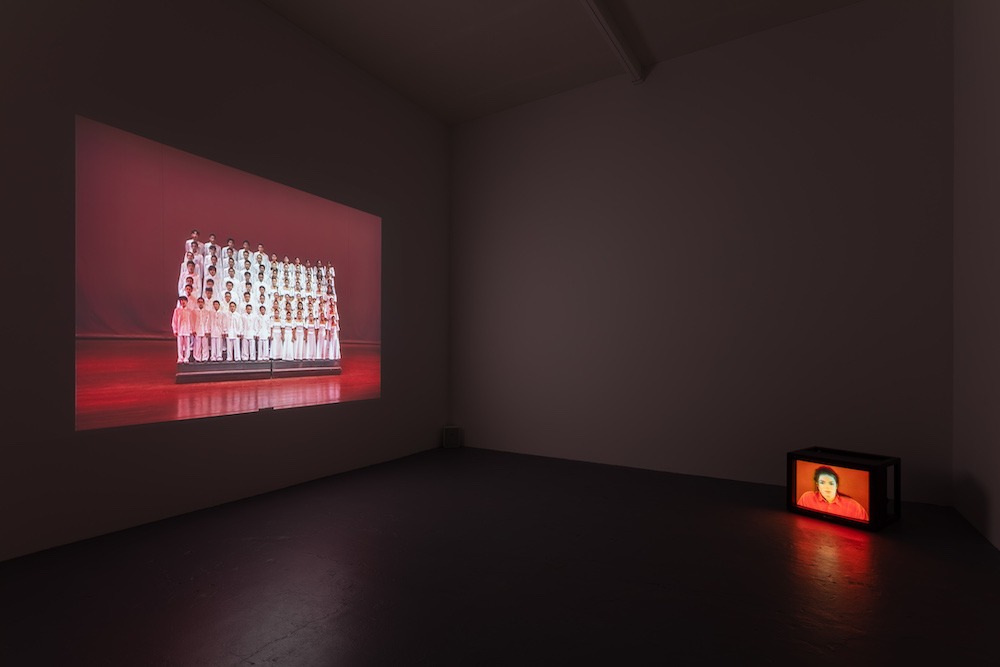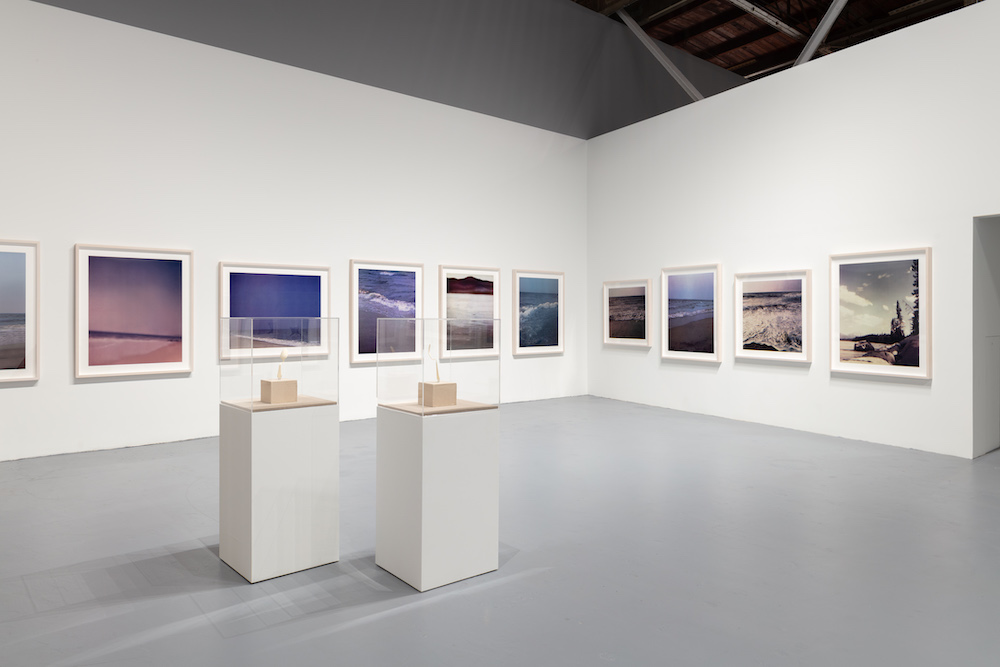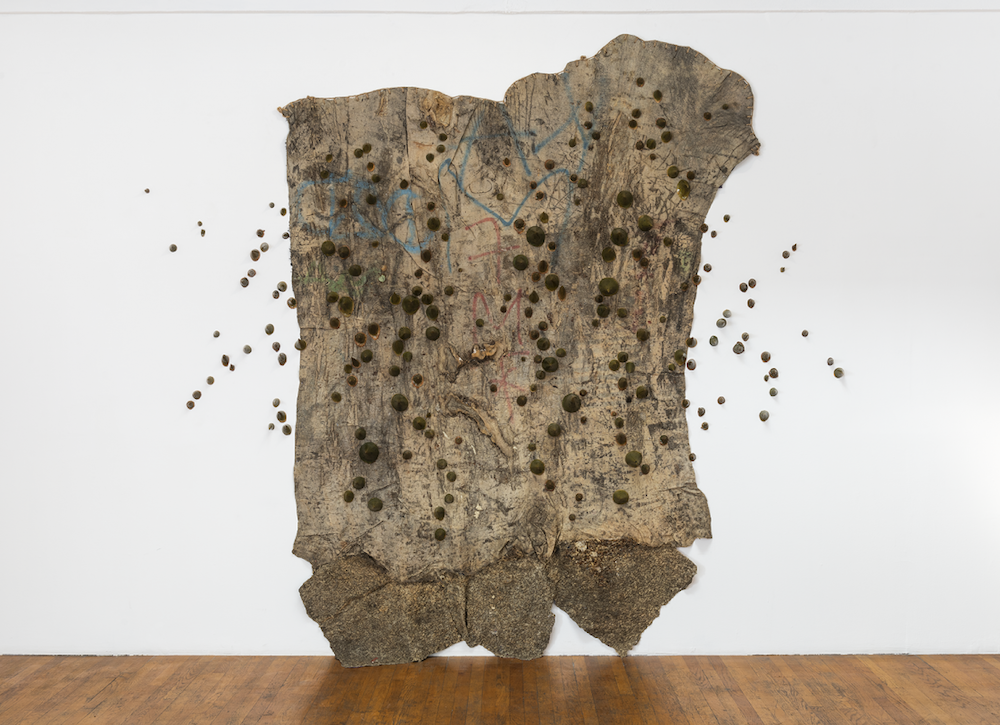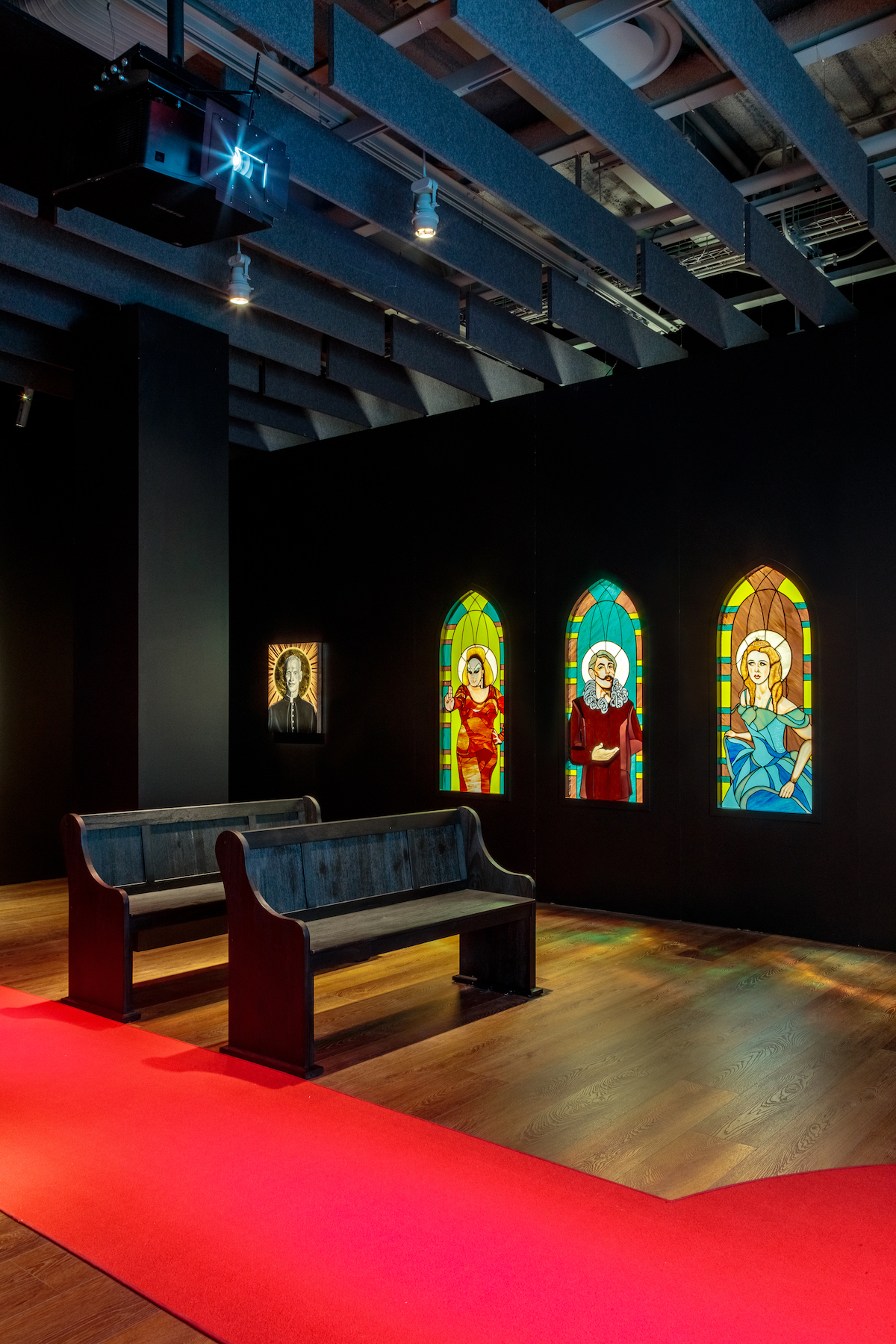Your cart is currently empty!
Byline: Leah Perez
-

GALLERY ROUNDS: Tidawhitney Lek and Veronica Fernandez
Sidecar GalleryAt Night Gallery’s newly debuted kunsthalle-inspired space, Sidecar, “What Will You Give?” features numerous large-scale paintings by up-and-coming artists Tidawhitney Lek and Veronica Fernandez. Lek and Fernandez present pieces of work that showcase both the tranquility and uncertainty of the domestic and internal intimate spaces.
Lek’s triptych painting entitled Richie’s Liquor depicts a scene of a nondescript time and space as a young man in the modern day walks into a liquor store where two soldiers wearing Vietnam War army fatigues stand reading a TV guide which features Arnold Schwarzenegger on the cover and a headline that reads “100 Greatest Heroes and Villains”, a possible nod to the U.S.’s ambiguous role in Cambodia, as well as Schwarzenegger’s character whose role as an aggressor and savior vacillates throughout the Terminator film series.
Lek showcases several still life and micro-landscapes in “What Will You Give?” focusing on the mundanity and beauty of an empty street or the sign of a shopping center, well complemented by Fernandez’s paintings of human subjects in and around their homes. Fernandez’s paintings depict mixed scenes and mashed-up events which evoke the contradictions one holds with their own home as both a place of safety and often the birthplace of our traumas. In Fernandez’s pseudo-reality paintings, faces are blurred, spaces are mixed together, and objects seem to float around unaffected by gravity.

Veronica Fernandez, Pillowflight (Nobody is Coming to Protect You), 2024. Photo: Ed Mumford. Courtesy of Sidecar Gallery. Fernandez’s painting Pillowflight (Nobody is Coming to Protect You) displays a TV floating in the air, playing wrestling, as a faceless figure imitates the move seen on TV ready to land on one of their unsuspecting friends, cousins, or siblings. The unsuspecting friends, however, are preoccupied and shown being attacked by a pair of dogs. As the subjects in time are frozen, we as an audience can’t help but want to intervene, to say “stop”, to protect the children whose own home seems to be a precarious space.
Both Fernandez and Lek point to a shared pain under a facade of beauty. Lek’s paintings employ glitter and scenes of blooming flowers or family members embracing and yet there is a remarkable sadness to these works and an eeriness of what’s to come. Fernandez’s ambiguous scenes and faceless subjects portray things within our families that are left unsaid and the fallibility of our own memories.
-

GALLERY ROUNDS: Paul Pfeiffer
The Museum of Contemporary Art“Paul Pfeiffer: Prologue to the Story of the Birth of Freedom” culminates in over thirty multimedia works of artist Paul Pfeiffer. The title of the exhibition references one of the works in the show which shows a video of director Cecil B. DeMille on loop exiting and entering theater curtains to present a screening of his biblical epic, The Ten Commandments (1956), the birth of freedom in this case referencing the birth of Moses. Though so much of the show focuses on popular culture in the West, I found myself questioning if the exhibit was rather the prologue to America and our pseudo-freedom represented through motifs of capitalism, nationalism and celebrity worship.
The exhibition is a maze of various photographic, video, auditory, and sculptural installations—an undertaking just as epic as The Ten Commandments. At the center of the maze is a room with a work entitled Live from Neverland (2006), which features a video of Michael Jackson delivering a very rehearsed press release speech denying accusations of child molestation, however Jackson is not the one speaking these words. Another video on a larger screen plays beside Jackson and features freshmen students at Silliman University in the Philippines performing Jackson’s monologue and providing Jackson’s audio for the installation. The work points to the world’s obsession with celebrity and a pivotal moment in the decline of Jackson’s legacy as an icon. In this work, Pfeiffer pulls back the curtain to show the hidden Brown labor behind all of our consumption, the Filipino students performing on behalf of a racially ambiguous star—another motif throughout the show. Many of the fabrications of Pfeiffer’s sculptures and installations employ the labor of artisans in the Philippines, Thailand and Latin America.

Installation view of “Paul Pfeiffer: Prologue to the Story of the Birth of Freedom,” November 12, 2023-June 16, 2024 at The Geffen Contemporary at MOCA. Courtesy of The Museum of Contemporary Art (MOCA). Photo: Zek Kelley. Incarnator, (2018 – ongoing) features an array of wooden body parts in the form of Justin Bieber, an image that has been featured on lamppost signs throughout Los Angeles advertising the show. It’s an image I’ve been plagued by—completely confused by the context of the work— but when face to face with Incarnator, I immediately understood. Utilizing carpenters known as encarnadores, Pfeiffer worked with Filipino, Spanish, and Latin American craftsmen whose job it is to make realistic renderings of Christ and saints for churches in Spain and its former colonies, and one that anyone from these countries would be well familiar with. As a Mexican American I cannot emphasize enough the religious zeal of Catholicism and its Baroque expressions in Latin America and its colonial cousin, the Philippines. This zeal transfers easily into other forms of worship and iconography whether that be celebrity, fútbol or nationalism.
Though the exhibition does not have a clearly labeled entrance or exit or directional flow, one could choose to walk in from several entrances and exits—a sort of choose-your-own-adventure. I was greeted by 24 Landscapes (2000/2008), a series of landscape photographs taken across beaches in Southern California, or so I thought. Upon reading the didactic text I learned these photos were from the final photo shoot of Marilyn Monroe before she died in 1962, but Pfeiffer has digitally erased her form from every one of these photos. Only thirty-six years old when she died and only an A-lister for some ten years (give or take a few) Monroe’s face has become as iconic and American as apple pie, though most fans couldn’t tell you a single thing about her. Many of the works in “Paul Pfeiffer: Prologue to the Story of the Birth of Freedom” point to a corporeal absence of the icon. In his erasure of various stars from their most recognizable places, Pfeiffer points to a cyclical process of replacing an old or disgraced icon with the next, whether it be Jesus, Justin Bieber, Manny Pacquio, or Bill Russell, another icon will be born to fill their shoes as is our cycle of freedom.
Paul Pfeiffer: Prologue to the Story of the Birth of Freedom is organized by Clara Kim, Chief Curator and Director of Curatorial Affairs, and Paula Kroll, Curatorial Assistant. It is on view at Geffen at MOCA until June 16, 2024.
-

GALLERY ROUNDS: Eddie Rodolfo Aparicio
Museum of Contemporary ArtThe Museum of Contemporary Art returns with its “Focus Series” featuring the first solo show of LA-based artist, Eddie Rodolfo Aparicio. “MOCA Focus: Eddie Rodolfo Aparicio” showcases some of Aparicio’s previous work of rubber castings and amber installations, while framing the larger narrative of Aparicio’s own life and body of work; a story that resonates with many other Salvadorans displaced by economic, colonial and punitive powers.
The show features several hanging tree castings taken of various trees throughout LA, as well as tapestries that combine rubber with fabric. Upon close examination, these rubber trees tell us a story of their lives, every cut, scratch and impalement a story. 601ft2 para el Lago Suchitlan / 601 sq. ft. for Lake Suchitlan (2023), one of Aparicio’s amber works, appears to slowly seep across the gallery floor, while trapped inside one can spot human bone, a shoe, a soccer ball, a Pizza Loca box, and even legal documents —ephemera which tells a disembodied story of someone unknown, like fossils trapped in time.
Upon entering “MOCA Focus: Eddie Rodolfo Aparicio,” the viewer is greeted by a mural of a cartoon chicken donned in green military gear and holding a green chicken drumstick. While this chicken may seem odd and out of place to foreign audiences, this chicken is held in great fondness within Central America and its diaspora. Started in Guatemala, “El Pollo Campero” is a famous restaurant chain in Central America that has become synonymous with the taste of home to many Central Americans. This depiction of the chicken serves as a not-so-subtle nod to El Salvador’s Civil War, in which El Salvador’s government murdered a number of leftist organizers, clergy members and civilians.
Born in 1990, only two years prior to the end of El Salvador’s Civil War, Aparicio takes it as his artistic responsibility to remind us that no matter how hard we may try to repress, rewrite, and revise the past, the future will remember.
-

GALLERY ROUNDS: “John Waters: Pope of Trash”
The Academy Museum of Motion PicturesThis September, the Academy Museum opened its John Waters retrospective entitled “John Waters: Pope of Trash,” shortly followed by Waters’ induction into the Hollywood Walk of Fame. The exhibit includes the glasses Mink Stole wore in Pink Flamingos (1972), costumes by Van Smith and a reproduction of the trailer Babs Johnson lives in in Pink Flamingos (1972). The world is experiencing a Waters revival and it’s about damn time. In the post-Trump era of cancel culture, and an increasing amount of anti-LGBT laws being passed in the US; Waters’ work is as relevant as ever.
It’s not uncommon in 2023 to hear people remark, “You could NEVER make that movie today!” usually in reference to the male-driven comedies of the 1970s, yet even today there remains no shortage of male-driven comedies that punch down at trans women, gay men and people of color. I attended the Academy Museum’s screening of Pink Flamingos, as part of the exhibition’s public programming. Though a long-time Waters fan, this was my first time seeing the film, which is still rather hard to find even in the era of streaming services. You could not make Pink Flamingos now, because there are several laws that would prohibit the film from being funded, made and distributed. The film notably features its starlet, Divine, eating fresh dog shit, a chicken being crushed to death during sex, and a scene in which a mother, played by Divine, performs fellatio on her son played by Danny Mills. Made prior to the culture wars of the 1980s, Pink Flamingos—against all odds—became an arthouse success through word of mouth, a cult following of fellow outsiders and independent media publications declaring the film a “must-see”.

“John Waters: Pope of Trash,” installation view, 2023. Photo: Charles White, JW Pictures. © Academy Museum of Motion Pictures. The beauty of Waters’ obscenities came not because the subjects of his films were the joke, but because those disgusted by his actors were the ones being mocked. The intended queer perverted audience understood the satire of lines of dialogue such as: “As you know, we run a baby ring. Oh, it’s really a very simple process. […] We sell the babies to lesbian couples and then we invest the money in various businesses around town.” These lines play into the image of what conservatives think homosexuals do for fun—which is obviously selling stolen babies to lesbian couples.
This very year, the state of Maryland decriminalized sodomy even though same-sex marriages were declared legal in all 50 states in 2015. While the left is constantly being pointed at and accused of canceling and censoring people, the right wants to end sex education in schools, ban drag shows and disallow teachers from naming their sexual orientation in the classroom. Yet while Waters has made some of the most offensive films of all time, his work remains relevant and important to those who know how to take a joke and whose voices have yet to be centered by mainstream media—the gays and girls who don’t look like Troye Sivan and Kim Petras.
Filth politics have never been more necessary and Waters’ work remains as hilarious and revolutionary as ever.
